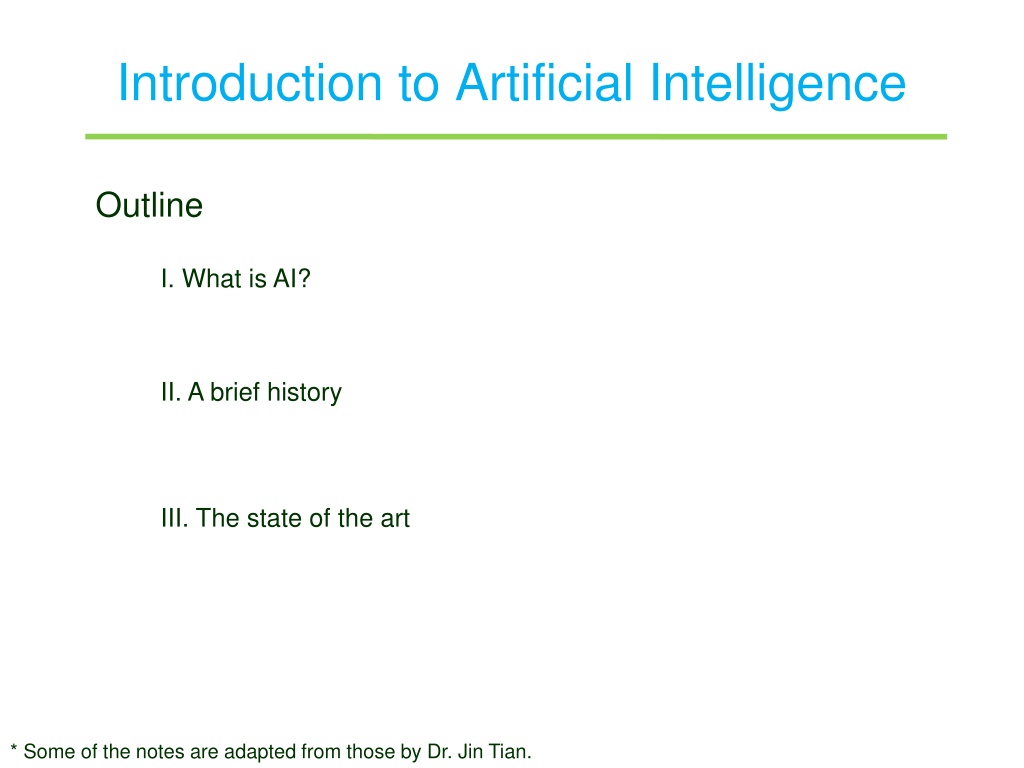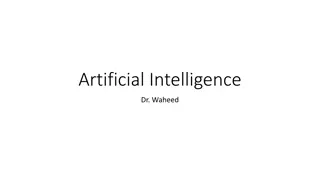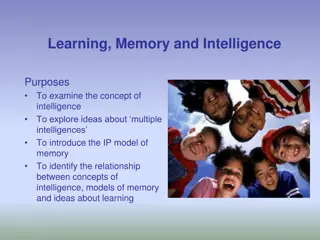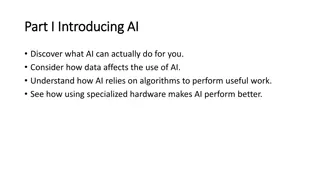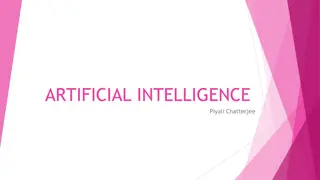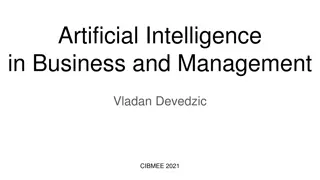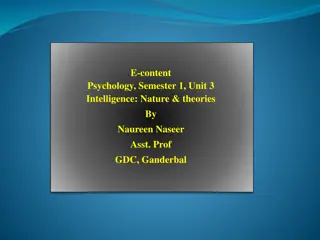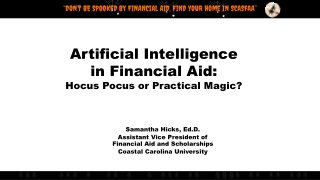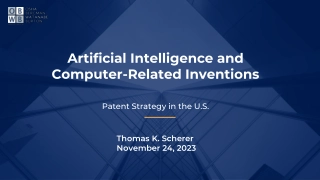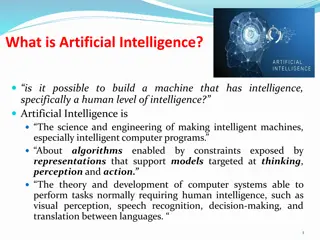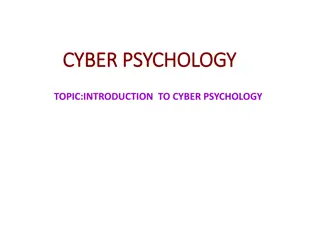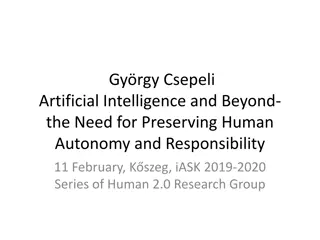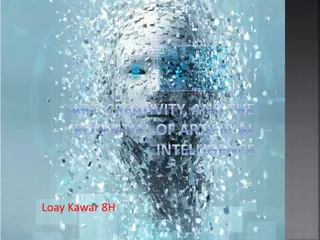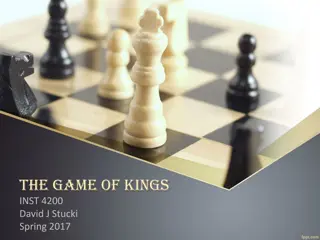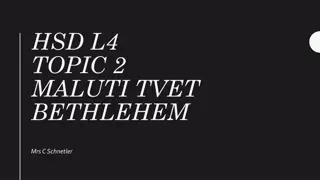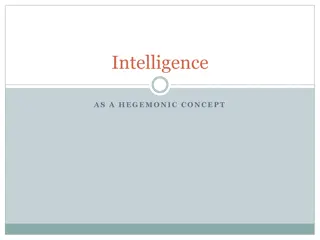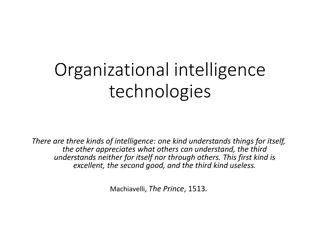Introduction to Artificial Intelligence: A Comprehensive Overview
Artificial Intelligence (AI) is a fascinating field that aims to make machines think and act intelligently. The outline covers the definition of AI, its historical development, and the current state of the art, including the capabilities required to pass the Turing test. The notes touch on various aspects of intelligence, such as perception, reasoning, learning, communication, and planning, highlighting the different approaches to AI - acting humanly and acting rationally. The exploration of AI disciplines like natural language processing, knowledge representation, automated reasoning, machine learning, computer vision, speech recognition, and robotics underscores the diverse applications and vibrant nature of AI today.
Download Presentation

Please find below an Image/Link to download the presentation.
The content on the website is provided AS IS for your information and personal use only. It may not be sold, licensed, or shared on other websites without obtaining consent from the author. Download presentation by click this link. If you encounter any issues during the download, it is possible that the publisher has removed the file from their server.
E N D
Presentation Transcript
Introduction to Artificial Intelligence Outline I. What is AI? II. A brief history III. The state of the art * Some of the notes are adapted from those by Dr. Jin Tian.
I. What Is Intelligence? A wish-list of general characteristics of intelligence Perception: manipulation & interpretation of data provided by sensors Action: control and use of effectors to accomplish a variety of tasks Reasoning: deductive (logical) inference, inductive inference Learning: adapting behavior to better cope with changing environments, discovery of patterns, learning to reason, plan, and act. Communication: with other intelligent agents including humans using signals, signs, icons, Planning: formulation of plans sequences or agenda of actions to accomplish externally or internally determined goals
What is AI? Thinking Humanly Thinking Rationally The exciting new effort to make computers think machines with minds, in the full and literal sense. (Haugeland, 1985) The study of mental faculties through the use of computational models. (Charniak and McDermott, 1985) [The automation of] activities that we associate with human thinking, activities such as decision-making, problem solving, learning .... (Bellman, 1978) The study of computations that make it possible to perceive, reason, and act. (Winston, 1992) Acting Humanly Acting Rationally The art of creating machines that perform functions that require intelligence when performed by people. (Kurzweil, 1990) Computational Intelligence is the study of the design of intelligent agents. (Poole et al, 1998) AI is concerned with intelligent behavior in artifacts. (Nilsson, 1998) The study of how to make computers do things at which, at the moment, people are better. (Rich and Knight, 1991)
Acting Humanly: Turing Test Alan Turing (1950) Operational definition of intelligence https://www.britannica.com/biography/Alan-Turing A human interrogator poses some written questions to another human and a computer (or robot ). The computer passes the test if the interrogator cannot tell whether the written responses come from the human responder or the computer. Human respondent Human interrogator Robot https://wsimag.com/science-and-technology/36961-no-turing-test-for-consciousne1ss Annual Loebner prize competition (since 1990): the first prize of $100,000 to be awarded to the first program that passes the "unrestricted" Turing test.
Six Disciplines of AI To pass the Turing test, the following capabilities are required: Natural language processing (NLP) to communicate in a human language; Knowledge representation to store what it knows; Automated reasoning to answer questions and draw new conclusions; Machine learning (ML) to adapt to new circumstances and to detect patterns. Total Turing test requires interaction with the real world. Computer vision (CV) & speech recognition to perceive the world; Robotics to move around in the world and to manipulate objects. Most vibrant and in-demand areas in AI today: ML, CV, NLP, and Robotics.
Thinking Humanly: Cognitive Modeling To say a program thinks like a human, we must know humans think first. Learn about human thought in three ways: introspection catching thoughts as they go by; psychological experiments observing a person in action; brain imaging observing brain activities. General problem solver (GPS) by Newell & Simon (1961) Also compares reasoning steps to those in the human solution. Cognitive science constructs theories of the human mind by combining computer models from AI experimental techniques from psychology
Thinking Rationally: Laws of Thought Represent problems using logic and build programs to create intelligent systems. Drawbacks: Not easy to state informal (and often uncertain) knowledge in the formal logical notation. Big difference between solving a problem in principle and solving it in practices.
Acting Rationally: Rational Agent This course is about designing rational agents. Rational behavior: doing the right thing expected to maximize goal achievement, given the available information An agent is an entity that perceives and acts. A rational agent is one that acts to achieve the best outcome.
Foundations of AI Artificial Intelligence Todaiji Temple Neuralscience Mathematics Economics Philosophy Control Theory Computer Engineering Linguistics Psychology
II. Brief History of AI 1943 McCulloh & Pitts: model of artificial neurons 1950 Turing s Computing Machinery and Intelligence 1956 McCarthy, Minsky, Newell, Simon, Shannon, Nash et al. Dartmouth workshop: birth of Artificial Intelligence 1952-69 Early enthusiasm, great expectations, optimism fueled by early success on some problems thought to be hard 1966-73 Collapse in AI research: Progress was slower than expected. Unrealistic predictions, Herbert Simon (1957) AI discovers computational complexity.
Brief History of AI (contd) 1969-86 Expert systems 1980- AI becomes an industry: expert systems booms, then busts (1988-93): AI Winter 1986- Neural networks regain popularity 1987- Probabilistic reasoning and machine learning
Brief History of AI (contd) 1995- Emergence of intelligent agents AI technologies continue to find applications in information retrieval data mining and knowledge discovery customizable software systems smart devices (e.g., home, automobiles) agile manufacturing systems autonomous vehicles bioinformatics internet tools: search engines, recommender systems Steady progress on fundamental AI research problems continues.
Brief History of AI (contd) 2001- Big data e.g., ImageNet 2011- Deep learning Successful large-scale real-world applications in image recognition natural language processing speech recognition machine translation Convolutional neural networks (CNNs) Chat Generative Pre-trained Transformer (ChatGPT)
Turing Award Winners in AI 1969 Marvin Minsky (MIT) 1971 John McCarthy (Stanford) National Medal of Science (1990) 1975 Allen Newell* (Carnegie Mellon) National Medal of Science (1992) Founding Fathers of AI Herbert Simon* (Carnegie Mellon) Nobel Prize in Economics (1978) National Medal of Science (1986) US News rankings of CS programs in AI (2023): 1994 Edward Feigenbaum (Stanford) Raj Reddy (Carnegie Mellon) 1. 2. 3. 4. Carnegie Mellon MIT Stanford Berkeley 2011 Judea Pearl (UCLA) 2018 Yoshua Bengio (U Montreal) Geoffrey Hinton (U Toronto) Yann Lecun (NYU & Facebook) *omitted by the textbook on p. 17. Big mistake!
Solomon Lefschetz Academic Genealogy Albert Tucker Herbert Simon Marvin Minsky John McCarthy Edward Feigenbaum Allen Newell Raj Reddy * All the photos are from https://amturing.acm.org/byyear.cfm.
III. The State of the Art Game playing Chinook defeated human checkers champions (1994). Deep Blue (IBM) defeated the reigning world chess champion Garry Kasparov (1997). Supercomputer Watson (IBM) beat human champions on Jeopardy (2011). AlphaGo (Google) beat the world s No.1 ranked player Ke Jie in Go (2017). Libratus (Carnegie Mellon) defeated the world s best Texas Hold em poker players head-to-head (2017), six-player (2019). AlphaStar AI (Google) defeated human pros at StarCraft II (2019)
(contd) Robotic vehicles Stanley (Stanford) won the DARPA Grand Challenge (2005) Boss (Carnegie Mellon) won the DARPA s Urban Challenge (2007) Self-driving cars by Tesla, Google, etc. Google car Tesla car crash Florida, 2016 Boss Stanley Legged robots (Boston Dynamics) Atlas Handle SpotMini
(contd) Autonomous planning NASA s Remote Agent program controlled the scheduling of operations for a space craft (2000). Uber and Google Maps plan optimal routes for hundreds of millions of users. Speech recognition Flight booking via conversation with an automated system Real-time speech-to-speech translation Image understanding ImageNet object recognition Image captioning Extensive use of convolutional neural networks (CNNs) Face recognition (boarding airplanes, bullet trains, etc.) Natural language processing ChatGPT by OpenAI allows user to steer and refine a conversation (2022)
Precautions, Downsides & Failures Has artificial intelligence become alchemy? Science, 4 May 2018, Vol 360, Issue 6388, p. 478 Lack of rigor No explanation why some algorithms work and why others don t. Inability to replicate results by others 2021's Top Stories About AI > Spoiler: A lot of them talked about what's wrong with machine learning today IEEE Spectrum, 27 Dec 2021 2021 was the year in which the wonders of artificial intelligence stopped being a story. Huge computational and energy costs of training deep learning systems AI s turbulent past and uncertain future (its boom-and-bust cycle) Is Deep Learning deep enough? AI failures: briittleness, embedded bias, catastrophic forgetting, explanability, common sense etc. AI is not a science. But it is changing our lives.
